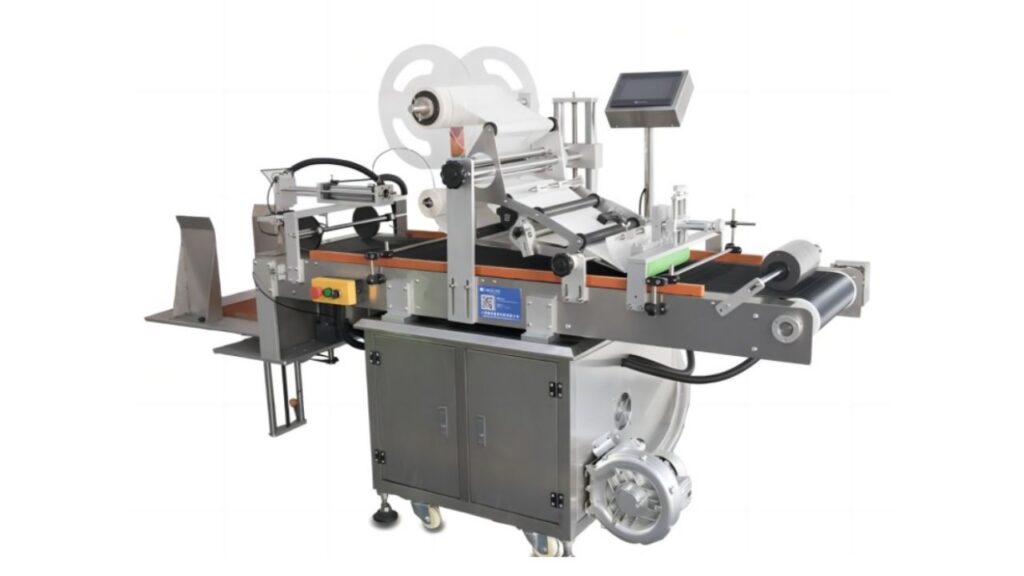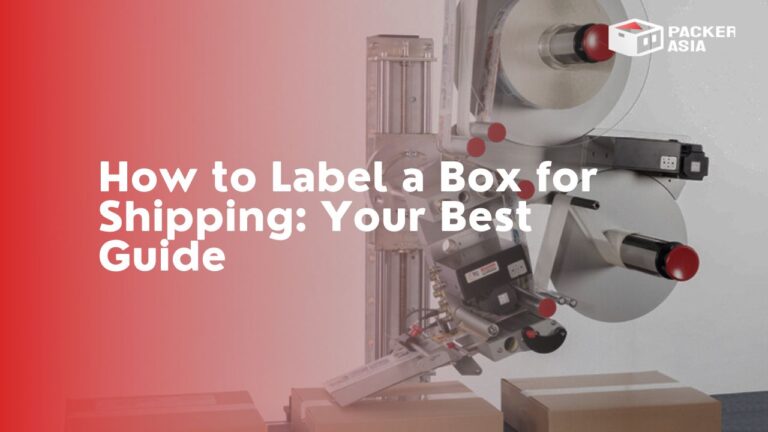Shipping labels are the guiding stars in the vast galaxy of logistics, guiding packages to their intended destinations.
Without the right shipping labels, packages can easily get lost in the labyrinthine transportation network. And that’s why it’s also important to choose a labeling machine that’s right for your business.
Feel free to ask us for more information on labeling machines.
All in all, there’s a lot to be gained from understanding the best practices for packaging and labeling packages and boxes. Read our guide on how to apply shipping labels to boxes and explore a variety of high-quality labels to make your shipping process a breeze.

What is a Shipping Label?
Shipping labels are like passports for packages, carrying vital information that ensures their smooth passage through the shipping journey. Understanding the key elements of a shipping label is essential to ensure accurate and effective labeling. These crucial elements include:
Sender Name & Address or Return Address: The sender’s information, allowing undeliverable packages to be returned.
Recipient Name & Address: The intended destination of the package.
Package Weight and Item Details: Information about the package’s contents and weight, helping carriers determine appropriate handling and shipping methods.
Unidirectional Code: A unique identifier for the package’s journey, enabling carriers to track and manage its movement.
Routing Code: Instructions for the package’s route, guiding it through the shipping network.
Postal Barcode: A machine-readable code that speeds up the sorting and processing of packages.
Service Type: The chosen shipping service, indicating the level of delivery speed and priority.
Tracking Number: An essential component for real-time tracking, allowing both shippers and recipients to monitor the package’s location and delivery status.
Direct Thermal Shipping Labels
Direct thermal shipping labels offer a convenient and efficient labeling solution for many shippers.
These labels require no ink or ribbons, as they are printed directly onto the label material.
With thermal printers, the heat activates the label material, producing crisp and durable prints.
Direct thermal shipping labels eliminate the need for additional printing supplies and reduce maintenance efforts, making them a popular choice for those seeking simplicity and cost-effectiveness.
How do I Label a Package for Shipping?
When it comes to labeling packages for shipping, you have two main options:
Purchasing Shipping Labels at Your Carrier’s Office:
This option involves visiting your carrier’s physical location, such as a post office or shipping center, to purchase pre-printed shipping labels. Once you have the labels, you can manually fill in the required information using a pen or marker.
Creating Shipping Labels Online (Carrier or Third-Party):
The more convenient and widely used option allows you to create shipping labels through your carrier’s online platform or third-party shipping label generators. These online tools enable you to enter the necessary information digitally and print the labels directly from your computer.
Pick Your Mailers/Box:
Selecting the appropriate mailers or boxes is crucial to ensure your items are well-protected during transit. Different types of mailers and boxes are available, catering to various shapes, sizes, and fragility levels of items being shipped. Here are some common options to consider:
Corrugated Cardboard Boxes: Sturdy and versatile, these boxes come in various sizes to accommodate a wide range of products.
Bubble Mailers and Padded Envelopes: Ideal for small, lightweight items requiring extra protection against impact and shock.
Poly Mailers: Lightweight and water-resistant, they are great for non-fragile items like clothing and accessories.
Flat Rate Boxes: Offered by some carriers, these boxes allow you to ship certain items at a fixed rate, regardless of weight or distance.
Choose the packaging that best suits your items and ensures they arrive at their destination intact.
Choose Your Labels
The type of labels you use can significantly impact the efficiency and professionalism of your shipping process. Various options are available, each suited for different applications and printing methods:
Standard Paper Labels: Suitable for basic shipping needs and commonly used with inkjet or laser printers.
Thermal Labels: Designed for thermal printers, these labels use heat to produce high-quality prints without the need for ink or toner.
Waterproof Labels: Ideal for items that may be exposed to moisture during transit, preventing smudging and ensuring label durability.
Integrated Labels: Combine the shipping label with a packing slip or invoice, streamlining the packing process and reducing the risk of misplacing paperwork.
Selecting the right type of label ensures clear and legible shipping information, minimizing the chances of errors and delays.
Address Your Labels
Properly addressing your shipping labels is vital to ensure smooth and timely deliveries. How you address your packages depends on whether you choose to label them by hand or print the labels:
Labeling a Box for Shipping by Hand:
If you opt for manual labeling, use a pen or marker to write legible, clear information on the shipping label. Make sure the recipient’s name and address, along with the sender’s address, are correct and easy to read.
Labeling a Box for Shipping by Printing:
When creating shipping labels online, double-check all the information you enter for accuracy. Verify the recipient’s address, ensuring it follows the correct format with no errors. Print the labels on the appropriate label sheets or thermal labels, ensuring the printer settings are correct for precise printing.
Accurate and clear addressing minimizes the risk of misdelivery and ensures your packages reach their intended destinations without delays.
Attach Your Labels
Once your shipping labels are ready, it’s time to attach them securely to your packages.
Proper label placement ensures they remain intact throughout the shipping journey.
How you attach your labels depends on the type of packaging:
Boxes:
For corrugated cardboard boxes, place the label on the top of the package, making sure it lies flat and is not obstructed by tape or any other material. Avoid covering barcodes or crucial information with tape to ensure the labels are machine-readable during sorting and processing.
Bubble Mailers and Padded Envelopes:
Attach the label securely to the front of the mailer, ensuring it is visible and unobstructed. Press down on all edges of the label to ensure it adheres firmly to the surface.
Poly Mailers:
Similar to bubble mailers, attach the label to the front surface of the poly mailer, ensuring it is flat and visible. Smooth out any wrinkles or air pockets to ensure the label adheres securely.
Using clear packing tape to secure the labels helps prevent them from peeling off during transit.
Avoid covering important information with tape or obscuring barcodes to ensure seamless package handling.
Identify and Mark Hazardous Materials
If your package contains hazardous materials, it’s essential to comply with regulations and ensure proper labeling to alert carriers and handlers of potential risks.
Different classes of hazardous materials require specific labels and markings, indicating the nature of the contents and the precautions to be taken during transportation.
It is crucial to familiarize yourself with the regulations governing the shipment of hazardous materials and apply the appropriate labels and markings accordingly.
Ship, Track, and Deliver
With your packages properly labeled and prepared, it’s time to send them on their way to their intended destinations. Hand the packages to your chosen carrier or schedule a pickup for convenient shipping.
Keep track of your shipments using the provided tracking numbers, allowing you and your recipients to monitor the packages’ progress and estimated delivery dates.
With real-time tracking, you can ensure timely arrivals and address any unexpected delays promptly.
How do I Label a Cardboard Box for Shipping?
Labeling cardboard boxes for shipping requires special attention, as these boxes are commonly used for heavier or larger items. Here are some expert tips to ensure the smooth journey of your cardboard-boxed packages:
Box Orientation: Place the shipping label on the top surface of the box to ensure easy visibility during handling and sorting.
Flat Surface: Ensure the area where you attach the label is flat and free of wrinkles or creases, allowing the label to adhere securely.
Covering Tape: Avoid taping over the shipping label, as this can obstruct the barcode and cause scanning issues.
Label Protection: For added protection, consider using a clear shipping label pouch to cover the label and shield it from potential damage or wear during transit.
By following these tips, you can ensure your cardboard-boxed packages are well-prepared for a smooth and successful journey for their recipients.
Can I Write my Shipping Label?
While printing labels is the most common method, writing a shipping label may be necessary in certain situations.
For instance, if you have limited access to printers or are shipping a small number of packages with basic information, handwritten labels may suffice.
However, keep in mind that printed labels offer better legibility, professionalism, and machine-readability, reducing the risk of errors during package handling and processing.
If you choose to write your shipping labels, make sure to use clear, legible handwriting, and avoid any smudges or errors that may hinder the package’s transit.
Labeling your Shipment
In short, mastering the art of labeling shipping boxes is a key part of successful logistics. We’ve also found that printing shipping labels with a trusted label printer can greatly reduce shipping hassles.
By following the guidelines provided in this comprehensive guide, you can confidently label your packages and get them to their recipients. For additional resources and support, consult the experts on this site for specific guides, tips, and tools.
FAQs
Can I reuse shipping labels for future shipments?
While some carriers may allow the reuse of shipping labels under specific conditions, it’s generally recommended to use a new label for each shipment to avoid potential issues or delays.
What information should I include in the return address?
The return address should contain the sender’s name, address, city, state, and ZIP code. This allows for the safe return of the package in case of delivery issues.
Can I track my package without a tracking number?
Unfortunately, without a tracking number, it’s not possible to track a package’s whereabouts in real-time. Be sure to retain the tracking number provided on your shipping label for easy monitoring.
Can I use regular paper for printing shipping labels?
Regular printer paper may not be ideal for shipping labels, as it may not have the necessary adhesive properties or durability required for successful transit. It’s recommended to use specialized label sheets or direct thermal labels for printing shipping labels.
What should I do if my shipping label is damaged or torn during transit?
If your shipping label is damaged or torn during transit, contact your carrier’s customer service immediately. They can assist you with resolving the issue and ensuring the package reaches its destination.
Can I print multiple shipping labels at once for multiple packages?
Yes, most carrier websites and third-party shipping label generators offer options for batch printing, allowing you to print multiple shipping labels for multiple packages in one go. Check the platform’s features to see if this option is available.
Are there any restrictions on shipping hazardous materials?
Yes, there are strict regulations and guidelines for shipping hazardous materials. It’s essential to comply with these regulations and properly label packages containing hazardous materials to ensure the safety of handlers and carriers.



